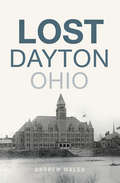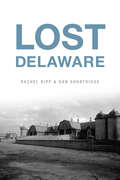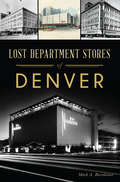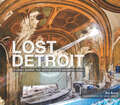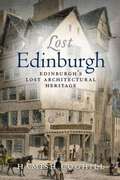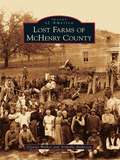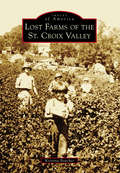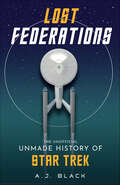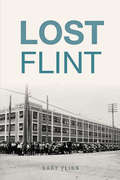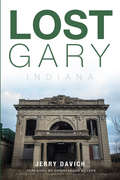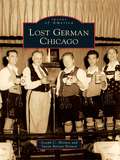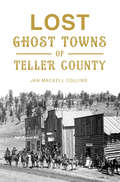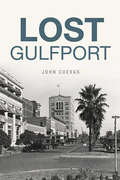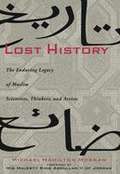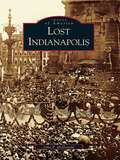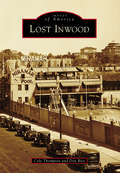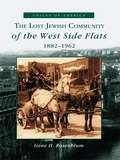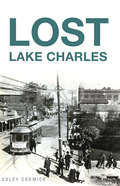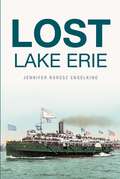- Table View
- List View
Lost Dayton, Ohio (Lost)
by Andrew WalshMany of the places that helped make Dayton a center of innovation were lost to history, while others survived and adapted, representing the city's spirit of revitalization. Some of the city's distinctive and significant structures, such as Steele High School and the Callahan Building, were demolished, while others, including the Arcade and Centre City Building, saw hard times but now await redevelopment. Entire neighborhoods, such as the Haymarket, and commercial districts, such as West Fifth Street, vanished and show no traces of their past. Others, including the popular Oregon District, narrowly escaped the wrecking ball. From the Wright Brothers Factory to the park that hosted the first NFL game, Andrew Walsh explores the diverse selection of retail, industrial, entertainment and residential sites from Dayton's disappearing legacy.
Lost Dearborn (Lost)
by Craig E. HutchisonThroughout its existence, Dearborn has been a pioneer settlement, a multicultural hub, a college town, a major tourism center and a world-renowned industrial city. Unfortunately, due to a variety of factors, significant structures have been lost to time. Almost all of the eleven U.S. Arsenal complex buildings have disappeared since the arsenal was closed in 1875. The hallways of the Edison School and Oxford School still live on in the hearts of their students but were razed long ago. Even beloved edifices such as the Ford Rotunda and the Ford Motor Company Administration building, built by Dearborn's favorite son, Henry Ford, are now only a memory. Author Craig E. Hutchison endeavors to immortalize the important foundational building blocks of an evolving city.
Lost Delaware (Lost)
by Rachel Kipp Dan ShortridgeFormer Delaware journalists Rachel Kipp and Dan Shortridge document the past, present, and sometimes the future of Delaware's landmarks and legends. Originally part of Pennsylvania and called "the three lower counties on the Delaware," the First State's present has been shaped by both colonial culture and modern industry. Many landmarks of its past, including the Greenbaum Cannery, the Rosedale Beach Hotel, the Nanticoke Queen restaurant, the Ross Point School and the Kahunaville nightclub now live solely in memory. The tales of airplanes and auto plants, breweries and bridges, cows and churches provide insight into the state's many communities, including its Black heritage. Read about fallen hospitals, long-ago lighthouses, crumbling mansions, demolished prisons and theaters that no longer hold shows.
Lost Denver
by Mark BarnhouseNewcomers to the "Mile-High City" of Denver, whether arriving during the 19th, 20th, or 21st centuries, have often remarked on how new the city seems, and how proud its citizens are of it. Heady boom times at various intervals have inspired successive waves of city builders eager to make their mark by building grand, new edifices. Often, these new wonders replaced older structures that earlier Denverites had once seen as great accomplishments. As Denver has grown to become the hub of a major American metropolis, remnants of its earlier heritage have vanished into history, leaving newcomers to ponder, "What makes Denver Denver?" and longtime residents to ask, "Where has my Denver gone?" Lost Denver celebrates what the city once built and has since lost, along with what has made it unique, exploring where and how Denverites once worked, shopped, and played.
Lost Department Stores of Denver (Lost)
by Mark A. BarnhouseDenverites once enjoyed a retail landscape rich with personal touches. Revisit May-D&F's animated holiday windows or the ice skating rink in front of the store. Reminisce about the Christmas chandeliers that stretched for four hundred feet on the main floor of the Denver Dry Goods or the elegance of Neusteters, with its fashion shows and exclusive merchandise. Recall finding that perfect outfit at Fashion Bar and going back-to-school shopping at Joslins. Celebrate salespeople who remembered your name and the comforting feeling of shopping locally where your parents and grandparents shopped. Through decades of research and interviews with former staff, Denver's unofficial "department store historian" Mark Barnhouse assembles the ultimate mosaic of the Mile High City's fabulous retail past.
Lost Detroit: Stories Behind the Motor City's Majestic Ruins (Lost Ser.)
by Dan AustinStories and photographs celebrating the city&’s history through its abandoned architectural landmarks. Lost Detroit tells the stories behind twelve of the city&’s most beautiful left-behind landmarks and of the people who occupied them, from the day they opened to the day they closed. While these buildings might stand as ghosts of the past today, their stories live on within these pages. This book brings you the memories of those who caught trains out of the majestic Michigan Central Station, necked with girlfriends in the balcony of the palatial Michigan Theatre, danced the night away at the Vanity Ballroom, and kicked out the jams at the Grande Ballroom. Filled with stunning and often moving photographs, it&’s a treasure for history and architecture buffs, as well as for native Detroiters. &“A fascinating journey.&” —John Gallagher, Detroit Free Press architecture critic, from the Foreword
Lost Edinburgh: Edinburgh's Lost Architectural Heritage (The Lost History Series)
by Hamish CoghillAn exploration of the stories behind the many buildings lost to history in Scotland&’s capital city. What happened to Edinburgh&’s once notorious but picturesque Tolbooth Prison? Where was the Black Turnpike, once a dominant building in the town? Why has one of the New Town designer&’s major layouts been all but obliterated? What else has been lost in Edinburgh? From Edinburgh&’s mean beginnings—&“wretched accommodation, no comfortable houses, no soft beds,&” visiting French knights complained in 1341—it went on to attract some of the world&’s greatest architects to design and build and shape a unique city. But over the centuries many of those fine buildings have gone. Some were destroyed by invasion and civil strife, some simply collapsed with old age and neglect, and others were swept away in the &“improvements&” of the nineteenth century. Yet more fell to the developers&’ swathe of destruction in the twentieth century. Much of the medieval architecture vanished in the Old Town, Georgian Squares were attacked, Princes Street ruined, old tenements razed in huge slum clearance drives, and once familiar and much-loved buildings vanished. The changing pattern of industry, social habits, health service, housing, and road systems all took their toll; not even the city wall was immune. The buildings that stood in the way of what was deemed progress are the heritage of Lost Edinburgh. In this informative book, author Hamish Coghill sets out to trace many of the lost buildings and find out why they were doomed. Lavishly illustrated, Lost Edinburgh is a fascinating insight into an ever-changing cityscape.
Lost Elkmont (Images of America)
by Daniel L. PaulinPrior to the formation of the Great Smoky Mountains National Park (GSMNP) in 1934, the small community of Elkmont was established as a logging camp by Col. Wilson B. Townsend's Little River Lumber Company around 1908. This was after he purchased 86,000 acres of mostly virgin forest. The area that was previously inhabited by various American Indian groups, and later by European-American settlers beginning around 1830, was to become for a time the second largest town in Sevier County, Tennessee. Colonel Townsend's business ventures proved successful beyond expectation, as he skillfully exploited the area's valuable hardwood forests. His logging company and railroad provided a mountain population with jobs and steady wages. Once all the valuable timber was harvested, Townsend sold land to private citizens who established what was to become an exclusive summer community that included both the Appalachian and Wonderland Clubs. These coexisted inside the GSMNP until 1992. This is the story of Elkmont.
Lost Evansville (Lost)
by Dr. James MacLeodFrom the Wabash and Erie Canal to the Faultless Caster Factory, Evansville has seen much of its history disappear. In the early twentieth century, vestiges of old Evansville like the B'nai Israel temple and Coal Mine Hill gave way to a modern city. Numerous changes in the thirty years following World War II altered the physical appearance of the city, including the removal of the old Central High School, Assumption Cathedral, Gear Town, and more. Less physical but nevertheless vital history like the struggle over Civil Rights in Evansville has been overlooked and, until now, lost. Weaving together a captivating fast-paced account illustrated with over eighty images, award-winning Evansville historian Dr James MacLeod tells the fascinating story of what was lost, what came in its place, and what was preserved against the odds.
Lost Farms of McHenry County
by Arabella Anderson Glynnis WalkerFarmers from the East found the broad and fertile prairies of McHenry County offered the perfect soil and climate for growing corn, wheat, oats, barley, and rye. This led the way for a flourishing dairy industry that eventually supplied milk to the city of Chicago. The first settlements appeared in 1835 in towns such as Crystal Lake, Woodstock, Harvard, and Cary. Families such as the Walkups, the Crandalls, the Beardsleys, the Stickneys, and the Terwilligers travelled by oxcart and rode on horseback from distant states. As word of the lush countryside spread, other farmers came from England, Ireland, and Germany to plow the fertile fields of the nation's heartland.
Lost Farms of the St. Croix Valley (Images of America)
by Kristina BoucherThe St. Croix Valley has been a haven for farmers since the first boom in the 1850s. The St. Croix River was a mecca for early industry, and the vast Minnesota and Wisconsin prairies have provided the natural resources for the region’s farmers to grow their crops and their families. The valley was dotted with brightly painted barns, a sign of economic success. However, as time wore on, the St. Croix Valley experienced an agricultural downturn. Barns have been left abandoned. Fields have been turned into subdivisions. An era has passed, and the barns and farms that were once proud reminders of the region’s success are disappearing from the countryside. But why? Lost Farms of the St. Croix Valley explores the history of the region, shares the photographs and stories of local farmers, and evaluates why the traditional family farm is falling by the wayside.
Lost Federations: The Unofficial Unmade History of Star Trek
by A. J. Black"An innovative and unusual account of Star Trek’s lost voyages that makes for a fascinating alternate history." — Brian J. Robb in Sci-Fi Bulletin SPACE. THE FINAL FRONTIER. THESE WERE ALMOST THE VOYAGES OF THE STARSHIP ENTERPRISE. We think we know the history of Star Trek. Born at the height of 1960s popular culture, the five-year mission of Captain James T. Kirk and his crew faced early cancellation, bounced back with a series of beloved movies in the 1980s and gave way to a fleet of successful sequels and spin-offs that kept on exploring strange new worlds. In Lost Federations: The Unofficial Unmade History of Star Trek, author A. J. Black tells a different story. This is an alternate history of the franchise, one filled with roads not taken, from early 1960s feature-films and spin-offs, the original sequel Star Trek: Phase II in the 1970s, via epic planned movies such as Planet of the Titans and into many untold episodes, arcs and character stories from The Next Generation, Deep Space Nine and Voyager, all the way through to the modern era. Bringing together pre-existing material over decades for the first time in one space, plus some new reflections from Star Trek writers and analysis of how it all fits into the wider cultural trends of the last sixty years, Lost Federations invites you to boldly explore a history you may not already know...
Lost Flint (Lost)
by Gary FlinnThe city of Flint waxed and waned with the automotive industry of the twentieth century. Where they have not vanished completely, crumbling signs of past opulence stand as painful reminders of more recent struggles. Hardly a trace remains of the Buick City factory complex that sprawled across the city's north side. The placid waters of Flint Park Lake once echoed with the sounds of an amusement park--games, dancing, circus acts and even a roller coaster. Flint Community Schools pioneered a model for how schools can function outside regular hours, but too many now are closed and deteriorating. Local author Gary Flinn uncovers the abandoned places and lost traditions from the Vehicle City's past.
Lost Fort Worth (Lost)
by Mike NicholsFrom the humble beginnings of a frontier army camp, Fort Worth transformed into a city as cattle drives, railroads, oil and national defense drove its economy. During the tremendous growth, the landscape and cultural imprint of the city changed drastically, and much of Cowtown was lost to history. Witness the birth of western swing music and the death of a cloud dancer. See mansions of the well-heeled and saloons of the well-armed. Meet two gunfighters, one flamboyant preacher, one serial killer and one very short subway carrying passengers back in time to discover more of Fort Worth. Author Mike Nichols presents a colorful history tour from the North Side to the South Side's Battle of Buttermilk Junction.
Lost Gary, Indiana (Lost)
by Jerry DavichA poster child for our nation's urban experimentation a century ago, Gary was forged with hype and hope, dreams and sweat, political agendas and tons of steel. The hardscrabble city attracted all kinds, from shady scoundrels and famous architects to hardworking immigrants and brilliant entrepreneurs. Boasting 180,000 residents at its peak, the booming melting pot eventually faded away under the afflictions of urban decay, racial unrest and political upheaval. Jerry Davich explores the remnants of Gary's glory days, from Union Station in ruins to City Methodist Church stripped of its soul. Revisit the Sheraton Hotel's demise, Emerson High School's hard lessons, Vee-Jay Records' last release and a devastated downtown filled only with façades and fond memories.
Lost German Chicago (Images of America)
by Joseph C. Heinen Susan Barton HeinenBy 1900, one in four Chicagoans was either German born or had a German-born parent. No other ethnic group's thumbprint has been larger in helping establish Chicago as a major economic and cultural center nor has any group's influence been more erased by the passage and vicissitudes of time. Lost German Chicago traces the mosaic of German life through the tumultuous events of the Beer Riots, Haymarket Affair, Prohibition, and America's entry into two world wars. The book is a companion piece to the Lost German Chicago exhibition debuting in the newly created DANK-Haus German American Cultural Center museum, located in what is still known today as the "German town" of the north side of Chicago. Entrusted as the caretaker of many archives, artifacts, and historical documents from many now defunct German organizations, the DANK-Haus German American Cultural Center has been committed to preserving history, traditions, and contributions of Germans and German Americans for over 50 years.
Lost Ghost Towns of Teller County (Lost)
by Jan Mackell CollinsThroughout Teller County, history lovers can find abandoned towns and forgotten main streets that once bustled with life and commerce. Even before Teller was carved from surrounding counties, the scenic mountains and lucrative mines of the gold rush era brought thousands of settlers and attracted resort owners and tycoons eager to exploit the rich setting. Seemingly overnight, towns in the Cripple Creek District and other places popped up, flush with gold and people looking for opportunity. As the ore disappeared, the miners moved on in search of the next big lode. One by one, the towns were all but forgotten. Join Jan MacKell Collins and discover the booming history, lost towns and hardy settlers of Teller County.
Lost Gulfport (Lost)
by John CuevasThe second largest city in the state, Gulfport is the business center of south Mississippi. Many of the city's cherished landmarks and businesses have been lost to Hurricanes Camille and Katrina, the development of shopping malls and Interstate 10. Gulfport's answer to the quintessential '50s malt shop, Stone's Ice Cream, became a favorite hangout for students, families and businessmen throughout its long history. The Paramount Theatre was famous for its annual Christmas raffle during the '50s. Known as the "Hosts of the Gulf Coast," the Friendship House Restaurant served up a great cup of coffee along with its celebrated Hospitality Menu. Historian John Cuevas takes a look back at Gulfport's shops, restaurants, nightclubs, cinemas and more from a bygone age.
Lost History: The Enduring Legacy of Muslim Scientists, Thinkers, and Artists
by Michael Hamilton MorganIn an era when the relationship between Islam and the West seems mainly defined by mistrust and misunderstanding, it is important to remember that for centuries Muslim civilization was the envy of the world. Lost History fills a significant void and is essential reading for anyone seeking to understand the major the early Muslims played in influencing modern society. Morgan reveals how early Muslim advancements in science and culture laid the cornerstones of the European Renaissance, the Enlightenment, and modern Western society. As he chronicles the Golden Ages of Islam, beginning in A.D. 570 with the birth of Muhammad, and resonating today, he introduces scholars like Ibn Al-Haytham, Ibn Sina, Al-Tusi, Al-Khwarizmi, and Omar Khayyam, towering figures who revolutionized the mathematics, astronomy, and medicine of their time and paved the way for Newton, Copernicus, and many others. And he reminds us that inspired leaders from Muhammad to Suleiman the Magnificent and beyond championed religious tolerance, encouraged intellectual inquiry, and sponsored artistic, architectural, and literary works that still dazzle us with their brilliance. Lost History finally affords pioneering leaders with the proper credit and respect they so richly deserve.
Lost Indianapolis
by John P. McdonaldIn 1816, the U.S. Congress decided to give the newly formed State of Indiana four square miles of land to lay out a capital city. Just where the capital city would be platted, however, was unknown. Four years later, the spot was finally chosen near where Fall Creek meets the White River. From that moment forward, despite a few bumps along the way, Indianapolis began its development into one of the nation's great cities. Over the course of that development, many buildings, companies, legends, and people have come and gone. While they are now only shadows of the past, they help to form the history and heart of Indianapolis.
Lost Informal Housing in Istanbul: Globalization at the Expense of Urban Culture
by F. Yurdanur Dulgeroglu-YukselThe dynamics of globalization brought a radical change in megacities and tensions between the stakeholders and dwellers against top-down urban renewal policies. This unique book provides a worldview of multi-stakeholders in the urban housing market. With a longitudinal research approach, it paves the way for interdisciplinary researchers to critically assess the urban renewal projects and update such studies. The urban renewal processes are implemented without participation, and the book highlights field-based information for policymakers. The reader will find, with the information provided from the field, why participation is necessary for a sustainable urban development, why there are different types of urbanizations, and how it works under different conditions. Better understanding of the challenges of urban renewal processes in the world cities is intended with the focus on the changing informal settlements. Istanbul is a megacity, housing more than half of its dwellers in informal settlements. After many decades of self-upgrading and silently communicating with the local authorities, the informal sector had become adapted and maintained its living spaces. Unexpectedly, the end of the first decade of the 21st century marked a radical urban land valuation and international investments. Top-down interventions started with naming Istanbul the 2010 European Capital of Culture. Then came the Law of Urban Transformation, which meant the fast decline of squatter housing and the speedy loss of its cultural value of the mahalle spirit, place identity. The book will raise curiosity on why the time has come to change the perspectives about the informal urban sector.
Lost Inwood (Images of America)
by Cole Thompson Don RiceInwood, the northernmost neighborhood of Manhattan, has a rich yet little-known history. For centuries, the region remained practically unchanged--a quaint, country village known to early Dutch settlers as Tubby Hook. The subway's arrival in the early 1900s transformed the area, once scorned as "ten miles from a beefsteak," from farm to city virtually overnight. The same construction boom sparked an age of neighborhood self-discovery, when vestiges of the past--in the form of mastodon bones, arrowheads, colonial pottery, Revolutionary War cannonballs, and forgotten cemeteries--emerged from the earth. Waves of German, Irish, and Dominican immigrants subsequently produced a vibrant urban oasis with a big-city/small-town feel. Inwood has also been home to wealthy country estates, pre-integration sports arenas, and a lively waterfront culture. Famous residents have included NBA legend Kareem Abdul-Jabbar, Basketball Diaries author Jim Carroll, and Hamilton creator/star Lin-Manuel Miranda.
Lost Jewish Community of the West Side Flats 1882-1962, The: 1882-1962 (Voices of America)
by Gene H. RosenblumBeginning in 1882, many Russian and Eastern-European Jews who fled to the United States settled in the "West Side Flats" in St. Paul, Minnesota. The area once stretched from the banks of the Mississippi River to the cliffs of the West Side Hills, about 320 acres in all, but has since fallen victim to the vagaries of the mighty river and the progress of "urban renewal." The Lost Jewish Community of the West Side Flats: 1882-1962 takes the reader on a pictorial tour down memory lane. The families, houses, businesses, streets, and synagogues-all vanished now-are brought back to life through vintage photographs from the archives of the Jewish Historical Society of the Upper Midwest, the Minnesota Historical Society, and the private collections of many former residents. This is a memoir of a historic neighborhood that can no longer be visited.
Lost Lake Charles (Lost)
by Adley CormierFires, hurricanes, neglect and progress erased much of Lake Charles’s physical history. The young town was a magnet for pirates and privateers, like the infamous Jean Lafitte, who conducted business at the mouth of what is today called the Contraband Bayou. Michigan Men, creoles and cowboys made their way to the fledgling Louisiana town to start new lives. A great lumber industry shaped the town in the nineteenth century. Streetcars ran routes around the clock seven days a week. Author and historian Adley Cormier delves deep into Lake Charles’s past to uncover a history that has been lost to time and change.
Lost Lake Erie (Lost)
by Jennifer Boresz EngelkingSerene one moment and destructive the next, Lake Erie's moods mirror its tumultuous role in history. As the site of Cleveland's Great Lakes Exposition, the lake offered visitors a respite from the Great Depression, and Hotel Victory, once considered the world's largest summer resort, drew thousands to Put-In-Bay. Daring postal workers dangerously crossed the ice-covered surface on hybrid "boats" and by foot. Canal Street, at the Buffalo Wharf, was once called "the Wickedest Street in America." The Erie is one of thousands of ships that lie in a solemn graveyard below the surface. And rum runners turned the lake into a watery highway for illegal booze during Prohibition. Author Jennifer Boresz Engelking reveals entertaining, heartbreaking, and nostalgic stories of the lost sites, businesses and industries of Lake Erie.
